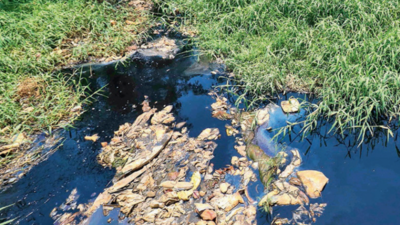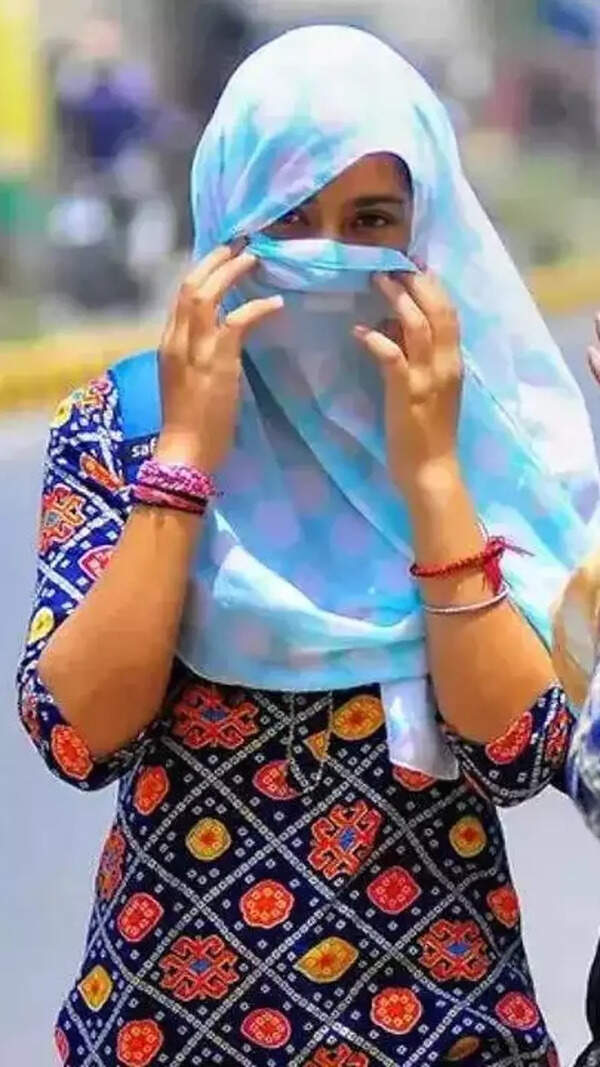- News
- City News
- gurgaon News
- Chemical streams flow into Yamuna in Sonipat
Trending Topics
Chemical streams flow into Yamuna in Sonipat

Most of these dyeing units discharge effluents into two drains that flow into the Yamuna.
SONIPAT: Sometimes dark blue, at other times red, currents of effluents discharged by around 100 dyeing units at Kundli in Sonepat reach the Yamuna all day in the Haryana district.
Despite a Punjab and Haryana high court order in 2015 to shift all dyeing units from residential areas of Sonipat, these remain operational at Piao Maniari and Friends Colony in the Kundli area, TOI found on Friday. Though the HSPCB has snapped the power supply to these units, that hasn't made a difference.
Most of these dyeing units have no treatment plants and discharge effluents into two drains-Mugeshpur and number 6-that flow into the Yamuna. An overwhelming pungent smell hangs in the air around these drains, which people living in the vicinity say they have learnt to live with.
In the Piao Maniari area, where around 1,000 people live along drain number 6, TOI found the sewer water was frothy and smelt strongly of chemicals.
"The drain here keeps changing colour. At some point in the day, it is bleached red and other times blue. It actually depends on the colours of the dye that is used in the illegal jeans-manufacturing units. The drain is severely polluted and its water is dirty, dark and smelly. Our life has become miserable because the constant stench," Bhola, a 53-year-old resident of Piao Maniari, said.
Another resident Rakesh Joshi said several people are suffering from skin rashes and allergies due to toxicity in the surroundings.
Delhi-based environment activist Varun Gulati, who recently filed a complaint, claimed the untreated water released by these dyeing units is high in ammonia and phosphates compounds that are toxic for aquatic life and also contaminate the groundwater. He said the pollution control board had not taken action against any of these illegal units.
"It is a matter of deep concern that these illegal units have continued to sprout, most with illegal power connections. Some of their lines were snapped during a joint operation by the discom and HSPCB officials, but more such units have cropped up," he said.
In its 2015 order, the Punjab and Haryana High Court directed all dyeing units to be shifted to another location that is connected to a common effluent treatment plant. However, there is no information on how many have actually been shifted, Gulati said.
A Central Pollution Control Board (CPCB) survey in 2021 found that drain number 6, which routes wastewater of Sonipat city and adjoining areas, had high levels of chemical oxygen demand (338 mg/L) and biological oxygen demand (90 mg/L). BOD for a river, waterbody or drain should be less than 30 mg/l and COD should be less than 250 mg/l, as per CPCB norms.
B Kamaljeet, regional officer of the Haryana Pollution Control Board in Sonipat, confirmed the presence of illegal dying units in the area. "We have been carrying out several drives to seal these illegal units. We have snapped their power connections as well. We have a district task force to deal with such units," he said.
Despite a Punjab and Haryana high court order in 2015 to shift all dyeing units from residential areas of Sonipat, these remain operational at Piao Maniari and Friends Colony in the Kundli area, TOI found on Friday. Though the HSPCB has snapped the power supply to these units, that hasn't made a difference.
Most of these dyeing units have no treatment plants and discharge effluents into two drains-Mugeshpur and number 6-that flow into the Yamuna. An overwhelming pungent smell hangs in the air around these drains, which people living in the vicinity say they have learnt to live with.
In the Piao Maniari area, where around 1,000 people live along drain number 6, TOI found the sewer water was frothy and smelt strongly of chemicals.
"The drain here keeps changing colour. At some point in the day, it is bleached red and other times blue. It actually depends on the colours of the dye that is used in the illegal jeans-manufacturing units. The drain is severely polluted and its water is dirty, dark and smelly. Our life has become miserable because the constant stench," Bhola, a 53-year-old resident of Piao Maniari, said.
Another resident Rakesh Joshi said several people are suffering from skin rashes and allergies due to toxicity in the surroundings.
Delhi-based environment activist Varun Gulati, who recently filed a complaint, claimed the untreated water released by these dyeing units is high in ammonia and phosphates compounds that are toxic for aquatic life and also contaminate the groundwater. He said the pollution control board had not taken action against any of these illegal units.
"It is a matter of deep concern that these illegal units have continued to sprout, most with illegal power connections. Some of their lines were snapped during a joint operation by the discom and HSPCB officials, but more such units have cropped up," he said.
In its 2015 order, the Punjab and Haryana High Court directed all dyeing units to be shifted to another location that is connected to a common effluent treatment plant. However, there is no information on how many have actually been shifted, Gulati said.
A Central Pollution Control Board (CPCB) survey in 2021 found that drain number 6, which routes wastewater of Sonipat city and adjoining areas, had high levels of chemical oxygen demand (338 mg/L) and biological oxygen demand (90 mg/L). BOD for a river, waterbody or drain should be less than 30 mg/l and COD should be less than 250 mg/l, as per CPCB norms.
B Kamaljeet, regional officer of the Haryana Pollution Control Board in Sonipat, confirmed the presence of illegal dying units in the area. "We have been carrying out several drives to seal these illegal units. We have snapped their power connections as well. We have a district task force to deal with such units," he said.
Start a Conversation
FOLLOW US ON SOCIAL MEDIA
FacebookTwitterInstagramKOO APPYOUTUBE







